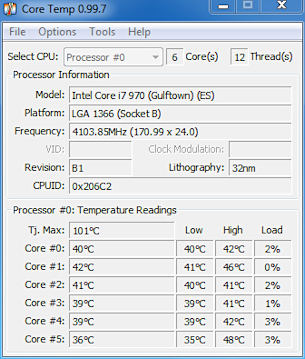Intel Core i7-970 Processor Review, Lower Cost 6-Core
Vital Signs and Overclocking
On the surface, the new Core i7-970 Extreme looks just like its socket 1366-based predecessors, as you can see in the image below. Ours is an engineering sample however, so the traditional retail model number markings are not listed here.

The Core i7-970 6-Core 3.2GHz Processor
The top half of the CPU is outfitted with the same basic heat-spreader design as every other Socket 1366 Core i7 processor and the chips use the same packaging. Internally, the new Core i7-970 is based on an updated core manufactured on a more advanced 32nm (nanometer) process versus early 45nm Nehalem-based Core i7 processors, but the individual execution cores are essentially identical. With the exception of support for some new instructions dubbed AES-NI (Advanced Encryption Standard New Instructions), which accelerate AES encryption and decryption algorithms in hardware, the Gulftown core in the Core i7-970 has the same features as Intel's Bloomfield (quad-core), the core used in previous Core i7 processors. As we noted earlier however, Gulftown, does feature a larger shared L3 cache--12MB versus Bloomfield's 8MB.
Other specifics regarding the Core i7-970 Extreme are listed in the CPU-Z screenshot below. The chip sports a 3.2GHz stock frequency, that can jump up to 3.46GHz in Turbo mode.

The QPI link for the Core i7-970 however, runs at 4.8GT/s (2.8GHz DDR). This is one notch down from the Core i7-980X Extreme process which runs a 6.4GT/s QPI (Intel Quick Path Interconnect) link. This speed difference quite frankly shouldn't amount to much variance in terms of performance clock-for-clock, however. The 970's base clock (listed incorrectly as bus speed by CPU-Z) runs at 133MHz. Not listed is the chip's max TDP, which happens to be 130W--the same as previous Core i7s and the Core i7-980X Extreme as well.
|
We also spent some time overclocking the new Core i7-970, as we do with virtually all new processors that come into our lab, in order to see what kind of frequency headroom it has available beyond just what Intel offers in its Turbo Boost settings. Using Intel's stock, retail cooler and with only the motherboard's Vdroop (CPU load line calibration) set to "enabled", we raised the chips reference frequency until our test system was no longer stable and then backed it down until we reached stability. Overclocking with the reference frequency, versus the chip's multiplier, for Intel non-Extreme Edition CPUs, is more of a real-world scenario that end users will have to attempt, since the Core i7 970 is multiplier locked above its stock 24X multiplier.

Intel Core i7-970 Overclocked To 4.1GHz and Stable - Stock Retail Intel Cooler
We were easily able to boot into Windows at 4.1GHz and could maintain stability while benchmarking. We achieved this at a 171MHz base reference frequency with the chip's stock multiplier. As always, depending on both the specific CPU you get as well as your motherboard, you may achieve decidedly different results.


Left: Core i7 970 At Idle 4.1GHz - Right: Core i7 970 Full Load 4.1GHz.
At those speeds, the stock Intel cooler kept the chip humming along at a cool low-40ºc temperature while idling, though temperatures peaked into the high 80ºC mark under load. Frankly, this is a little on the warm side for our comfort zone but then again, we were heavily overclocking this chip with standard air cooling. If you're the more exotic type when it comes to cooling, 4.1GHz should be easily achieved with water or certainly with some sort of refrigerant, should you go that route.






